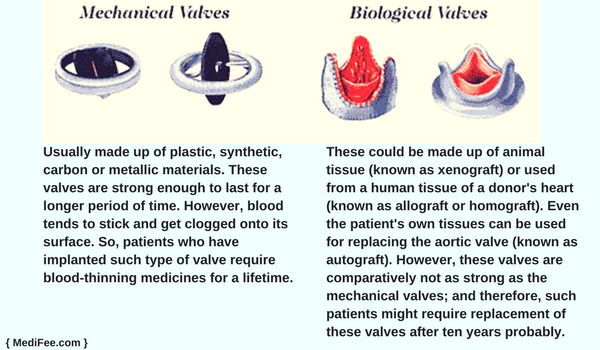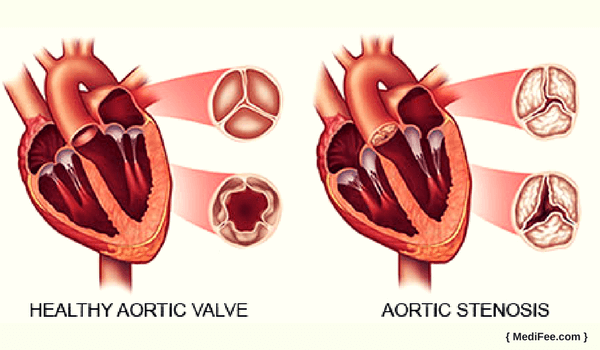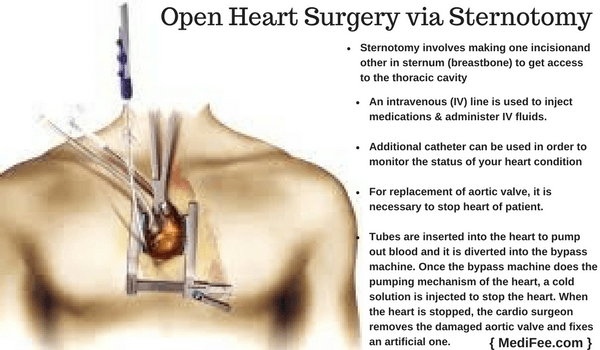Aortic Valve Replacement Surgery
Listed below is the step by step procedure of aortic valve surgery:
- What is an Aortic Valve Replacement Surgery?
- Why is Aortic Valve Replacement Surgery Required?
- Pre-operative Preparations
- Day Before Surgery
- Procedure Day
- Methods/Techniques of Aortic Valve Replacement Surgery
- Post Procedure
- Risks and Complications
What is an Aortic Valve Replacement Surgery?
An aortic valve replacement surgery is a procedure to remove a defective or damaged aortic valve of your heart and replace it with an artificial one. Most replaced aortic valves are made up of animal tissues or synthetic material.
There are basically two types of valves that are used for a aortic valve replacement surgery, which include:

- Mechanical Valves
Usually made up of plastic, synthetic, carbon or metallic materials. These valves are strong enough to last for a longer period of time. However, blood tends to stick and get clogged onto its surface. So, patients who have implanted such type of valve require blood-thinning medicines for a lifetime.
- Biological Valves
These could be made up of animal tissue (known as xenograft) or used from a human tissue of a donor's heart (known as allograft or homograft). Even the patient's own tissues can be used for replacing the aortic valve (known as autograft). Such patients do not require blood thinning medications. However, these valves are comparatively not as strong as the mechanical valves; and therefore, such patients might require replacement of these valves after ten years probably. A biological valves is known to breakdown faster in children and adolescents, so these type of valves are mainly used for elderly patients.
Why is Aortic Valve Replacement Surgery Required?
Need for replacing an aortic valve can be due to various reasons like narrowed, weakened, damaged, defective or failed aortic valve. The above reasons can be further explained as follows:
- Age is one of the major for cause of weakening of your blood vessels. After a certain age, you may require an aortic valve replacement surgery.
- One can be born with a defective aortic valve. Such individuals can face heart problems and may require valve replacement surgery.
- Certain type of cancers can affect and damage the blood vessel of your heart. At such incidences, there is a possibility that your aortic valves gets affected and needs to be discarded and replaced.
- Severe inflammation and/or infection caused within the walls of your aortic valves can also be one of the reasons that requires an urgent need for removal and replacement of your aortic valve.
- An aortic valve failure occurs when it fails to function properly or dysfunctions because of aortic valve diseases. It is one of the most common reason that calls for a valve replacement surgery.
- Blockages due to the formation of plaque within the walls of your aortic valves can narrow the passage ways of blood flow. These can be mainly treated using angioplasty. In some serious cases, it may also need replacement surgery.
- Other reasons may include aortic valve disease, complications arising from a previous operated valves, etc.
- Regurgitation:
It is also known as aortic insufficiency. In such type of a disease, the valves fail to close completely which makes the blood to leak in the reverse direction, i.e., backwards into the heart.
- Stenosis:
Stenosis is a condition where the aortic valves do not open enough to let the blood leave the heart and flow to the other parts of the body.

Pre-operative Preparation
There are certain preoperative measures that are very useful for your cardiologist to learn about the condition of your heart. Some diagnostic tests can be required before the surgery in order to learn about various aspects of your aortic valve. Let us learn about these diagnostic tests in detail.
- Electrocardiaogram (EKG or ECG):
This diagnostic test is useful to check the problems with the electrical activities of your heart. The aim of this test is to measure the electrical activity of the heart beat. With every heart beat, an electrical impulse travels through your heart. These impulse causes the muscles of your heart to squeeze and pump blood from the heart. Any abnormality present will appear in the ECG. Doctor might require the reports of this test to check the rate at which the aortic valves are pumping and other related vulnerabilities.
- Blood Tests:
A blood test is required to determine many aspects of your body. Let us learn them one by one.
- Blood Sugar Level:
Blood sugar level should be checked before the surgery, especially for diabetic patients. If there is any increase or decrease in this level, doctor takes certain actions to normalize it, when your go for the surgery. If this level does not become normal till the time of surgery, your doctor will delay the time of surgery or postpone its date.
- White blood cell count:
Blood tests are carried out to calculate the count of WBC. Increase in the count can show presence of infections in your heart., thus, delaying your surgery.
- Blood group:
Making a note of your blood group is important. Any heart related surgery can experience a lot of blood loss. A blood group is an important factor required for blood transfusion.
- Renal Function Test (RFT) and Liver Function Test (LFT):
During an aortic valve surgery, there is a lot of load on your kidneys and liver, thus, a pre-diagnostic RFT and LFT is required to see if these organs are working properly.
- Red Blood Cell Count and Haemoglobin:
If the count of your RBC or haemoglobin is less, there won't be enough oxygen-rich blood flow in your system. Doctors make sure that it is normal so that the surgery goes smoothly.
Apart from these blood tests, there is also a test included in your preoperative period that checks whether the donor aortic graft is compatible (if it is used).
- Urine Test:
Urine tests are mainly performed to determine bacteria or any other forms of infections in your system. Proprietary measures are carried out to reduce and deal with these health conditions. It also indicates possibilities of infections in the tissues of your heart.
- Chest X-Ray
An X-ray of your chest is very useful for the surgeon to learn about heart's size. It is a necessary procedure before the surgery.
Day Before Surgery
Day before your surgery, your cardiologist will inform you about food and water intake . This may include fasting or having a light meal before the surgery. Doctor will also explain you the complete procedure about how the surgery goes and ask you to sign a consent form for your approval. Other necessary do's and dont's will also be explained by your doctor. Make sure you follow all the instructions and schedule of the surgery.
Procedure Day
Day of your surgery begins with a routine check up that involves checking your vitals. Patient's will be taken to the surgical room after the check up is done. Your body will be injected with general anesthesia so that it remains unconscious and you do not experience any pain while your aortic valve replacement surgery is in progress.
Aortic valve replacement surgery begins with making a cut on your chest to get access to your heart. The extent of cuts made depends on the type of surgery being performed. There are various methods for replacement of aortic valve through surgery.
After the surgery is successfully implemented, your inner cuts will be sutured. The outer cuts will also be stitched. Track of your blood pressure and other vitals are constantly recorded to ensure that the patient's condition is normal while the surgery is going on. Cotton bandages are used to cover the wounds to avoid bleeding. Patient's are regularly monitored in order to check if there are no immediate side effects occurring.
Methods/Techniques of Aortic Valve Replacement Surgery
An aortic valve replacement surgery can be performed using various methods and techniques. These techniques vary based on your health condition. Also, your doctor selects one of these methods based on how urgently is it required for your heart condition.
There are three types of aortic valve replacement approaches as explained below:
- Open Heart Surgery via Sternotomy
Sternotomy involves making one incision in the thorax in order to receive a wide view of the thoracic cavity. This is followed by making other incisions in the sternum (breastbone) to get access to the thoracic cavity for your open heart surgery.

An intravenous (IV) line will be used to inject medications and administer IV fluids. Also, additional catheter can be used in order to monitor the status of your heart condition as well as collect blood samples if required. Catheters are also inserted in your collarbone and groin for other purposes.
For replacement of aortic valve, it is necessary to stop your heart. Tubes are inserted into the heart to pump out blood and it is diverted into the bypass machine. Once the bypass machine does the pumping mechanism of the heart, a cold solution is injected to stop the heart. When the heart is stopped, the cardio surgeon removes the damaged aortic valve and fixes an artificial one.
After completion of aortic valve replacement surgery, the blood will be allowed to enter your heart by taking off the machine's support. A paddle shock will be used to restart your heart. Once your heart starts beating, your surgeon will closely monitor it; mainly your aortic valve, to check how well it's working. Also, it is ensured that there are no leaks from the surgery.
The sternum will be rejoined via stitching. Skin over the incisions will be stitched. Other incisions will be stapled or stitched.
- Minimally Invasive Cardiac Surgery (MICS)
There are approaches that require your surgeon to open your breastbone so as to get a direct access to your heart for performing the surgery. As a result of such opening, it takes around several months for your wounds to heal completely.
A minimally invasive aortic valve replacement surgery involves mini-sternotomy that includes around 3-4 smaller incisions. These cuts are made on the upper section of your chest by dividing only the upper region of the breastbone. The remaining procedure is similar as that of a standard aortic valve replacement surgery.
A minimally invasive approach can be adopted using a robot. A robotic assisted surgery consists of control console, 3 robotic arms, a special visualizing device and other surgical instruments. The computer uses a control console to guide the surgeon's natural hand to perform the steps of surgery. The robot's can read even the tiniest of the surgeon's hand movement. This surgery has an advantage of utilizing less time as compared to a manual surgery.
- Trans-catheter Aortic Valve Replacement (TAVR) Surgery
It is a minimum invasive approach to replace and implant a damaged aortic valve. In this procedure, a catheter is put inside an artery of your groin and directed towards your heart. A balloon is placed at the inserted end of the catheter that contains the replacement valve folded around it. It is used to deliver the new valve at the place of the old one for substitution. The tissue valve is composed of a bovine (cow) pericardium having a stent support. When the catheter has reached the required position, the balloon is inflated to fit the tissue valve in place and then deflated to withdraw the catheter.
A TAVR Surgery is mainly used for patient's having aortic stenosis. It is performed with a beating heart and does not require a bypass machine. This procedure is similar to that of angioplasty.
Post Procedure
After successful execution of a aortic valve replacement surgery, surgeons can insert some wires into your heart for pacing. These wires are connected to a pacemaker outside your body for sometime to pace your heart. This can be usually required during initial days of the recovery period.
Also, tubes will be inserted into your chest to drain out blood and other fluids from and around your heart. These tubes are attached to a suction device to drain fluids out of your heart as it undergoes healing.
The wounds that are sutured or stitched are secured with sterile cotton bandages. A cotton dressing can also be done at those areas.
- Recovery at the Hospital
You will have to stay back at the hospital for around a week after your surgery. During this stay, your heart condition is minutely monitored by a team of doctors. Blood can be transfused in your system during this time if necessary. In the same manner, glucose can also be transfused.
Before you are sent back home, your doctor will educate you on all the important aspects you should follow at home for a better recovery. Along with it, he/she will also provide you with some medications for internal healing as well as pain relief. For patients who have been implanted with a mechanical aortic valve, blood thinning medicines are prescribed.
Your doctor may also discuss with you to schedule the next appointment for a visit. Follow ups are very important to make a note about your heart conditions.
- Recovery at the Hospital
Follow-up appointments are very important part of your recovery phase. They notify you about the following:
- Are all your vitals normal?
- Whether your inner as well as outer wounds are healing well enough?
- Are there any signs of infections?
- Are there any occurrences of abnormal conditions?
- Is there any internal or external swelling?
- Are the medicines showing any improvement or is it required to stop or replace them?
- Are there any side effects or changes taking place within or around your heart and other organs?
- Recovery at Home
You must follow the diet plan suggested by your doctor. It is very necessary to consume a healthy, nutritious and energy-rich diet everyday to help your body heal in a better way. Also, such diet is essential to make your body strong enough to bear strong medications. Keep your body hydrated by drinking at least 8 glasses of water and glucose-rich beverages that provide energy when your body is weak. Make sure you consume your medicines on time. Get enough sleep. If you experience any unusual situation at home post-operation, discuss with your doctor right away. It takes round about two to three months for your body to recover completely.
- Precautions
There are many precautionary steps you must follow to avoid any further complications . Such precautionary steps include:
- Avoid straining your chest
- Avoid sleeping on your chest
- Avoid lifting heavy objects
- Avoid smoking and drinking, that may disturb your healing process. It also puts a negative impact on your medication.
- Avoid performing any rigorous activities
- Avoid activities like bending and running
- Life After Surgery
Patients who have undergone an aortic valve replacement surgery using a biological valve may require to go for the same surgery again after around ten years. For patients who have had a mechanical aortic valve implantation require to consume blood thinning medications all their life.
Risks and Complications
Aortic valve replacement surgery is a complex operation and many risks are associated. Some of the most common risks for this surgery include:
- Internal or external wound infections
- Infections in the lungs, heart or bladder\
- Irregularities in your heart beat, which can be temporary (arrhythmmia)
- Blood clots
- Decrease in the functioning of your kidneys
- Strokes
Smaller aortic complications can be treated by your doctor. However, the risk of death because of an aortic valve replacement surgery is about 1-3%, which mainly arises due to severe complications that cannot be treated. Although, most people live a normal life after complete recovery.

